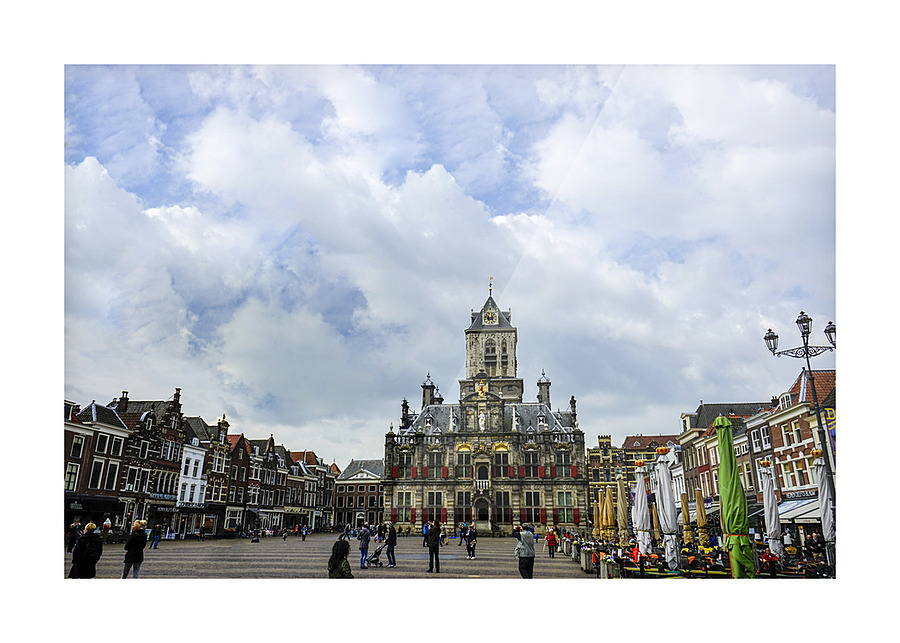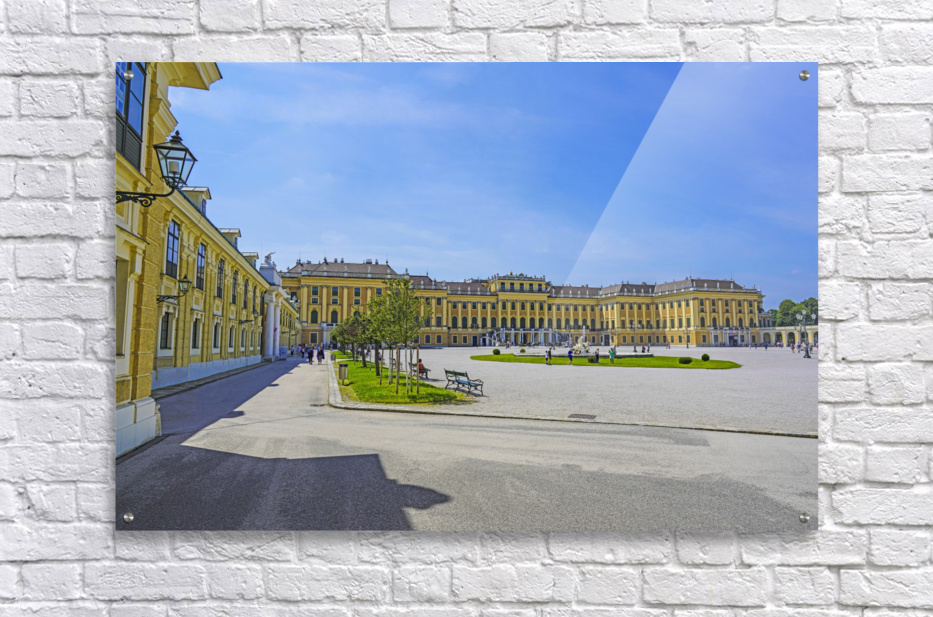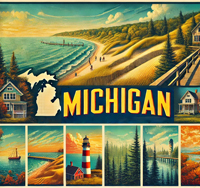

Embark on a journey curated by seasoned explorers William and Hui Cha Stanek, who have spent decades immersing themselves in the diverse landscapes of North America. These itineraries are more than just travel plans - they are thoughtfully crafted adventures designed to help you connect with the natural world, discover hidden gems, and create lasting memories.
National Parks Index | US Itineraries Index | American Roadtrips Index
- (May 30, 2025) Exploring Acadia and White Mountain
- Introduction: A 2-Day Journey Through the Northeast's Natural Marvels
- Day 1: Exploring the Majesty of Acadia National Park
- Morning: Sunrise at Cadillac Mountain
- Midday: Exploring the Ocean Path Trail
- Afternoon: Hiking the Beehive Trail
- Evening: Sunset at Bass Harbor Head Lighthouse
- Day 2: Delving into the Wilderness of White Mountain National Forest
- Morning: Sunrise at Cathedral Ledge
- Midday: Exploring the Kancamagus Highway
- Afternoon: Hiking the Franconia Ridge Loop
- Evening: Sunset at the Sugar Hill Overlook
- Conclusion: A Journey Through New England's Natural Marvels
- Choosing the Right Lodging: Enhancing Your Acadia and White Mountain Adventure
- Lodging Options in Bar Harbor, Maine (Ideal for Exploring Acadia National Park)
- Lodging Options in North Conway, New Hampshire (Central to White Mountain National Forest)
- Lodging Tips for Your Dual Adventure
- Lodging Options Between Acadia National Park and White Mountain National Forest
- Lodging in Bethel, Maine (Midway Point Between Acadia and White Mountain)
- Lodging in Bridgton, Maine (Convenient for Exploring Both Parks)
- Lodging Tips for Your Midway Stop
- Reservations and Timed Entry Information

Bring home a Bugville Critters book and watch as your child's love for reading and learning grows with every page. Hand-painted illustrations bring the heartwarming stories to life. Ask your librarian to add Bugville Critters to the library's digital collection today!
Discover William Stanek's Exclusive Art Collection
Explore and purchase the stunning art featured on this site. Own a piece of William Stanek's unique and captivating artwork today!
(May 30, 2025) Exploring Acadia and White Mountain
Introduction: A 2-Day Journey Through the Northeast's Natural Marvels
The northeastern United States is home to some of the most stunning and diverse landscapes in the country. From the rugged coastline of Maine to the towering peaks of New Hampshire, this region is a haven for nature lovers and outdoor enthusiasts alike. For us, William and Hui Cha, exploring Acadia National Park and White Mountain National Forest was an unforgettable journey into the heart of New England's wild beauty.
For Hui Cha, the rocky shores and misty forests of Acadia were a reminder of the power and serenity of the ocean, while the sweeping vistas and challenging trails of the White Mountains spoke to the grandeur of the mountains. For me, William, this adventure was about capturing the contrasts and nuances of these two remarkable landscapes – from the crashing waves along Acadia's coastline to the panoramic views from the peaks of the White Mountains.
This dual adventure was more than just a photographic expedition; it was a journey of discovery and connection with the natural world. In this guide, we'll take you through our detailed itineraries, share specific tips and techniques for photographing these iconic locations, and offer alternative activities for those seeking a more relaxed experience. Whether you have just one day or a full three days to explore, this guide will help you make the most of your journey through two of the Northeast's most breathtaking parks.
Day 1: Exploring the Majesty of Acadia National Park

Morning: Sunrise at Cadillac Mountain
5:00 AM - Sunrise at Cadillac Mountain
Overview: Start your adventure in Acadia National Park with a sunrise at Cadillac Mountain, the highest point on the East Coast of the United States. From this vantage point, you can witness the first light of the day as it breaks over the Atlantic Ocean, casting a warm glow over the rocky coastline and the surrounding islands. The views from the summit are nothing short of spectacular, making this an unforgettable way to begin your day in Acadia.
Tips from William: "Arrive at least 30 minutes before sunrise to secure a good spot and set up your camera. Use a wide-angle lens to capture the expansive view of the ocean, the islands, and the distant horizon. A tripod is essential for ensuring sharpness in the low light. The best shots often come just as the first light hits the landscape, creating a beautiful contrast between the warm tones of the sunrise and the cool blues of the early morning sky."
Insights from Hui Cha: "The air is crisp and cool in the early morning, so be sure to dress in layers. Cadillac Mountain is a popular spot, especially at sunrise, so expect to share the experience with other early risers. Despite the crowd, there's a sense of shared awe and reverence that makes the moment feel even more special. Take a moment to breathe in the fresh sea air and appreciate the beauty of the landscape as the day begins."
How to Access Cadillac Mountain:
- Location: Cadillac Mountain is located in the central part of Acadia National Park, accessible by a paved road that leads to the summit.
- Travel Directions: From Bar Harbor, drive south on Eagle Lake Road, then take the Park Loop Road until you reach the turnoff for Cadillac Summit Road. Follow this road to the top. The drive takes about 20 minutes from Bar Harbor.
- Trail Details: While you can drive to the summit, there are also several hiking trails that lead to the top, including the North Ridge Trail and the South Ridge Trail, both of which offer stunning views along the way.
Alternative Activity: Sunrise at Sand Beach
- For a less crowded option, consider watching the sunrise from Sand Beach, located on the eastern shore of Mount Desert Island. The beach offers beautiful views of the rising sun over the ocean and the rugged cliffs that line the shore.
Photographic Techniques:
- Golden Hour Lighting: The soft, golden light of sunrise will enhance the warm tones of the landscape. Use this light to highlight the contours of the mountains and the ocean, creating a sense of depth in your images.
- Wide-Angle Landscapes: The sweeping views from Cadillac Mountain are perfect for wide-angle photography. Use a wide-angle lens to capture the full scope of the landscape, including the ocean, the islands, and the distant horizon.
- Silhouettes and Detail Shots: Focus on the intricate details of the landscape, such as the texture of the rocks and the play of light and shadow across the terrain. A telephoto lens can help you zoom in on specific areas of the scene, capturing the textures and patterns that make this area unique.
Exploring the Area:
- After photographing the sunrise, consider exploring the summit area further by hiking one of the short trails that wind through the rocky landscape. These trails offer additional viewpoints and opportunities for photography.
Midday: Exploring the Ocean Path Trail
10:00 AM - Ocean Path Trail Exploration
Overview: The Ocean Path Trail is one of the most scenic and accessible hikes in Acadia National Park, following the rugged coastline from Sand Beach to Otter Point. Along the way, you'll pass some of the park's most iconic landmarks, including Thunder Hole, a natural rock formation that creates dramatic waves and spray when the tide is right. The trail is relatively flat and easy to navigate, making it perfect for a leisurely midday walk.
Tips from William: "The midday light can be harsh, but the dramatic coastline and the deep blue of the ocean provide plenty of opportunities for striking images. Use a polarizing filter to deepen the colors and reduce glare. A wide-angle lens will allow you to capture the full scope of the coastline, while a telephoto lens can help you zoom in on specific details, such as the crashing waves, the rugged rocks, and the distant islands. The contrast between the bright sky and the dark rocks can create dramatic compositions, so experiment with different angles and perspectives."
Insights from Hui Cha: "The Ocean Path Trail is a great way to experience the beauty of Acadia's coastline at your own pace. The trail is well-marked and offers stunning views at every turn. Take your time and be patient if you're waiting for the perfect shot, especially at popular spots like Thunder Hole. The sound of the waves crashing against the rocks and the fresh sea breeze make this a truly refreshing and invigorating walk. Don't forget to bring plenty of water and sunscreen, as the trail is exposed to the sun for much of the way."
How to Access the Ocean Path Trail:
- Location: The Ocean Path Trail begins at Sand Beach and follows the coastline south to Otter Point.
- Travel Directions: From the Cadillac Mountain area, drive south on the Park Loop Road until you reach the Sand Beach parking area. The trail begins at the far end of the parking lot. The drive takes about 15 minutes from Cadillac Mountain.
- Trail Details: The Ocean Path Trail is a 4.4-mile round-trip hike with a flat and easy path. The trail is well-marked and offers numerous viewpoints along the way, including Thunder Hole, Monument Cove, and Otter Cliffs.
Alternative Activity: Jordan Pond Path
- For a different experience, consider walking the Jordan Pond Path, a 3.4-mile loop around the clear waters of Jordan Pond. The trail is relatively flat and offers beautiful views of the surrounding mountains, including the iconic Bubble Mountains.
Photographic Techniques:
- Wide-Angle Landscapes: The expansive views of the coastline are perfect for wide-angle photography. Use a wide-angle lens to capture the full scope of the scene, including the ocean, the rocks, and the distant islands.
- Wave Motion: Use a fast shutter speed to freeze the motion of the waves as they crash against the rocks, or experiment with a slower shutter speed to create a sense of movement in the water. A tripod can help keep your camera steady during long exposures.
- Detail Shots: Focus on the intricate details of the coastline, such as the textures of the rocks, the patterns of the waves, and the play of light on the water. A macro lens can help you capture close-up shots of the smaller elements that make the scene unique.
Exploring the Area:
- After exploring the Ocean Path Trail, consider stopping for lunch at the Jordan Pond House, where you can enjoy a traditional Maine meal, including their famous popovers, while taking in views of Jordan Pond and the surrounding mountains.
Afternoon: Hiking the Beehive Trail
2:00 PM - Beehive Trail Hike
Overview: The Beehive Trail is one of Acadia National Park's most thrilling and challenging hikes, offering a steep and exposed climb to the summit of the Beehive, a prominent granite peak overlooking Sand Beach and the surrounding coastline. The trail involves scrambling over rocks, climbing iron rungs, and navigating narrow ledges, making it an exciting adventure for those with a head for heights. The views from the top are breathtaking, with sweeping vistas of the ocean, the cliffs, and the distant islands.
Tips from William: "The afternoon light can be harsh, but the dramatic scenery and the unique angles of the Beehive Trail provide plenty of opportunities for stunning images. Use a wide-angle lens to capture the expansive views from the summit, and a telephoto lens to zoom in on specific details, such as the textures of the granite, the patterns of the waves, and the distant islands. The contrast between the bright sky and the dark rocks can create dramatic compositions, so experiment with different angles and perspectives."
Insights from Hui Cha: "The Beehive Trail is a challenging and exhilarating hike, with steep climbs and exposed sections that require caution and confidence. Be sure to wear sturdy hiking boots and bring plenty of water, especially on warm days. The trail is about 1.5 miles round-trip, with a steep ascent that rewards you with incredible views. The sense of accomplishment you'll feel when you reach the summit is well worth the effort. Take your time and enjoy the adventure, but be mindful of your footing, especially on the exposed sections."
How to Access the Beehive Trail:
- Location: The Beehive Trail begins at the Sand Beach parking area and ascends the Beehive, a prominent granite peak overlooking the coastline.
- Travel Directions: From the Ocean Path Trail, walk back to the Sand Beach parking area, where the Beehive Trail begins. The trailhead is clearly marked and easy to find.
- Trail Details: The Beehive Trail is a 1.5-mile round-trip hike with a steep and challenging ascent. The trail involves scrambling over rocks, climbing iron rungs, and navigating narrow ledges, making it suitable for experienced hikers only.
Alternative Activity: Gorham Mountain Trail
- For a less strenuous option, consider hiking the Gorham Mountain Trail, a 3.5-mile round-trip hike that offers beautiful views of the coastline and the surrounding mountains. The trail is moderately challenging but less exposed than the Beehive Trail, making it a great alternative for those seeking a less intense experience.
Photographic Techniques:
- Wide-Angle Landscapes: The expansive views from the summit of the Beehive are perfect for wide-angle photography. Use a wide-angle lens to capture the full scope of the landscape, including the ocean, the cliffs, and the distant islands.
- Detail Shots: Focus on the intricate details of the trail, such as the textures of the granite, the iron rungs, and the surrounding vegetation. A macro lens can help you capture close-up shots of the smaller elements that make the scene unique.
- Action Shots: Capture the excitement of the climb by photographing hikers as they navigate the iron rungs and the narrow ledges. Use a fast shutter speed to freeze the action and create dynamic images that convey the thrill of the hike.
Exploring the Area:
- After hiking the Beehive Trail, consider relaxing at Sand Beach, where you can enjoy a refreshing swim in the cool Atlantic waters or simply unwind on the soft sand while taking in the stunning coastal scenery.

Evening: Sunset at Bass Harbor Head Lighthouse
6:30 PM - Sunset at Bass Harbor Head Lighthouse
Overview: End your day in Acadia National Park with a sunset at Bass Harbor Head Lighthouse, one of the most iconic and photogenic landmarks in the park. Perched on a rocky cliff overlooking the ocean, the lighthouse is beautifully framed by the rugged coastline and the setting sun. The warm light of the evening enhances the colors of the rocks, the water, and the lighthouse itself, creating a scene that is both peaceful and dramatic.
Tips from William: "Arrive about an hour before sunset to set up your shot and secure a good spot. Use a wide-angle lens to capture the full scope of the scene, including the lighthouse, the rocks, and the ocean. A graduated neutral density filter can help balance the exposure between the bright sky and the darker foreground. The best shots often come just after the sun has dipped below the horizon when the sky is filled with soft, pastel colors. The warm, golden light of sunset is perfect for highlighting the contours of the lighthouse and the surrounding landscape."
Insights from Hui Cha: "Bass Harbor Head Lighthouse is a popular spot, especially at sunset, so expect to share the experience with other photographers and visitors. Despite the crowd, there's a sense of shared appreciation for the beauty of the scene that makes the moment even more special. The lighthouse itself is a symbol of the rugged beauty of the Maine coast, and the view from the cliffs is truly breathtaking. Bring a light jacket, as the temperature can drop quickly after the sun sets, and take your time to enjoy the beauty of the landscape as the day comes to an end."
How to Access Bass Harbor Head Lighthouse:
- Location: Bass Harbor Head Lighthouse is located on the southwestern tip of Mount Desert Island, within Acadia National Park.
- Travel Directions: From the Beehive Trail area, drive southwest on the Park Loop Road, then take Route 102A to the Bass Harbor Head Lighthouse parking area. The drive takes about 45 minutes.
- Trail Details: The lighthouse is easily accessible from the parking area, with a short, easy trail leading to the viewpoint. The area offers several other trails that explore the surrounding cliffs and coastline.
Alternative Activity: Sunset at Otter Cliffs
- For a different sunset experience, consider visiting Otter Cliffs, located along the Ocean Path Trail. The cliffs offer stunning views of the ocean and the rugged coastline, with the added bonus of fewer crowds.
Photographic Techniques:
- Golden Hour Lighting: The soft, golden light just before sunset is ideal for landscape photography. Use this light to highlight the contours and textures of the lighthouse, the rocks, and the ocean, creating a sense of depth in your images.
- Silhouettes: As the sun sets behind the lighthouse, use its silhouette against the colorful sky to create striking compositions. A graduated neutral density filter can help balance the exposure between the bright sky and the darker foreground.
- Foreground Elements: Include some of the surrounding rocks, vegetation, or the waves in the foreground to add depth and interest to your landscape shots. The contrast between the bright colors of the sunset and the dark foreground can create stunning compositions.
Exploring the Area:
- After sunset, consider staying a bit longer for some stargazing. The night sky at Bass Harbor is incredibly clear, making it an excellent place for night photography. The view of the Milky Way rising above the lighthouse is particularly stunning, and you can capture it in all its glory.
Day 2: Delving into the Wilderness of White Mountain National Forest
Morning: Sunrise at Cathedral Ledge
5:30 AM - Sunrise at Cathedral Ledge
Overview: Start your day in White Mountain National Forest with a sunrise at Cathedral Ledge, a dramatic granite cliff that offers sweeping views of the surrounding mountains and valleys. From this vantage point, you can watch the first light of the day as it illuminates the rugged landscape, casting a warm glow over the forests and peaks. The views from the top are nothing short of breathtaking, making this an unforgettable way to begin your day in the White Mountains.
Tips from William: "Arrive at least 30 minutes before sunrise to set up your shot. Use a wide-angle lens to capture the expansive view of the mountains and valleys. A tripod is essential for ensuring sharpness in the low light. The best shots often come just as the first light hits the landscape, creating a beautiful contrast between the warm tones of the sunrise and the cool blues of the early morning sky."
Insights from Hui Cha: "The air is crisp and cool in the early morning, so be sure to dress in layers. Cathedral Ledge is a popular spot for sunrise, but the atmosphere is peaceful and serene, with plenty of space to find your own quiet corner. The view from the top is truly awe-inspiring, with the mist rising from the valleys and the mountains stretching out into the distance. Take a moment to breathe in the fresh mountain air and appreciate the beauty of the landscape as the day begins."
How to Access Cathedral Ledge:
- Location: Cathedral Ledge is located near North Conway, New Hampshire, within White Mountain National Forest.
- Travel Directions: From North Conway, drive west on West Side Road, then turn onto Cathedral Ledge Road and follow it to the top. The drive takes about 15 minutes from North Conway.
- Trail Details: You can drive to the top of Cathedral Ledge, or you can hike the Cathedral Ledge Trail, a 2.8-mile round-trip hike that offers additional viewpoints along the way.
Alternative Activity: Sunrise at Echo Lake
- For a less strenuous option, consider watching the sunrise from Echo Lake, located at the base of Cathedral Ledge. The lake offers beautiful reflections of the surrounding mountains and the rising sun.
Photographic Techniques:
- Golden Hour Lighting: The soft, golden light of sunrise will enhance the warm tones of the landscape. Use this light to highlight the contours of the mountains and valleys, creating a sense of depth in your images.
- Wide-Angle Landscapes: The sweeping views from Cathedral Ledge are perfect for wide-angle photography. Use a wide-angle lens to capture the full scope of the landscape, including the mountains, the forests, and the distant horizon.
- Detail Shots: Focus on the intricate details of the landscape, such as the texture of the granite cliffs, the mist rising from the valleys, and the play of light and shadow across the terrain. A telephoto lens can help you zoom in on specific areas of the scene, capturing the textures and patterns that make this area unique.
Exploring the Area:
- After photographing the sunrise at Cathedral Ledge, consider exploring the Echo Lake area further by taking a short walk around the lake or hiking one of the nearby trails that wind through the forested landscape.

Midday: Exploring the Kancamagus Highway
10:00 AM - Kancamagus Highway Exploration
Overview: The Kancamagus Highway, also known as the "Kanc," is one of the most scenic drives in New England, winding through the heart of the White Mountains and offering breathtaking views of the surrounding peaks, forests, and rivers. Along the way, you'll find numerous pullouts and trailheads that provide access to some of the area's most beautiful and iconic spots, including waterfalls, overlooks, and historic sites.
Tips from William: "The midday light can be harsh, but the vibrant colors of the landscape and the variety of scenic stops along the highway provide plenty of opportunities for striking images. Use a polarizing filter to deepen the colors and reduce glare. A wide-angle lens will allow you to capture the full scope of the landscape, while a telephoto lens can help you zoom in on specific details, such as the waterfalls, the rocky cliffs, and the distant mountains. The contrast between the bright sky and the rich greens of the forest can create dramatic compositions, so experiment with different angles and perspectives."
Insights from Hui Cha: "The Kancamagus Highway is a beautiful and peaceful drive, with plenty of opportunities to stop and explore along the way. The road winds through some of the most picturesque parts of the White Mountains, with stunning views around every bend. Take your time and enjoy the journey, stopping at the various pullouts to take in the scenery and capture the perfect shot. Don't forget to bring plenty of water and snacks, as there are few services along the highway."
How to Access the Kancamagus Highway:
- Location: The Kancamagus Highway runs for 34.5 miles between the towns of Lincoln and Conway, New Hampshire, within White Mountain National Forest.
- Travel Directions: From Cathedral Ledge, drive south to North Conway, then take Route 112 west to the start of the Kancamagus Highway. The drive takes about 30 minutes from North Conway.
- Scenic Stops: Some of the most popular stops along the Kancamagus Highway include the Lower Falls, Sabbaday Falls, Rocky Gorge, and the Sugar Hill Overlook. Each of these stops offers unique opportunities for photography and exploration.
Alternative Activity: Franconia Notch State Park
- For a different scenic drive, consider exploring Franconia Notch State Park, located just north of the Kancamagus Highway. The park offers stunning views of the White Mountains, as well as access to popular spots like the Flume Gorge, the Basin, and the Cannon Mountain Aerial Tramway.
Photographic Techniques:
- Wide-Angle Landscapes: The expansive views along the Kancamagus Highway are perfect for wide-angle photography. Use a wide-angle lens to capture the full scope of the landscape, including the mountains, the forests, and the rivers.
- Waterfalls and Rivers: The highway offers several opportunities to photograph waterfalls and rivers. Use a slow shutter speed to capture the motion of the water, creating a smooth, silky effect. A tripod can help keep your camera steady during long exposures.
- Autumn Colors: If you're visiting in the fall, the vibrant autumn colors along the Kancamagus Highway are a photographer's dream. Use a polarizing filter to enhance the colors and reduce glare, and experiment with different compositions to capture the beauty of the fall foliage.
Exploring the Area:
- After exploring the Kancamagus Highway, consider stopping for lunch in Lincoln or North Conway, where you'll find a variety of restaurants and cafes offering local specialties and New England charm.
Afternoon: Hiking the Franconia Ridge Loop
2:00 PM - Franconia Ridge Loop Hike
Overview: The Franconia Ridge Loop is one of the most iconic and challenging hikes in the White Mountains, offering a thrilling adventure along a narrow ridge with panoramic views of the surrounding peaks and valleys. The hike takes you over three of New Hampshire's 4,000-foot peaks – Little Haystack Mountain, Mount Lincoln, and Mount Lafayette – and rewards you with some of the most breathtaking views in the region. The trail is long and strenuous, but the sense of accomplishment and the incredible scenery make it well worth the effort.
Tips from William: "The afternoon light can be harsh, but the dramatic scenery and the unique angles of the Franconia Ridge Loop provide plenty of opportunities for stunning images. Use a wide-angle lens to capture the expansive views from the ridge, and a telephoto lens to zoom in on specific details, such as the textures of the rocks, the patterns of the clouds, and the distant mountains. The contrast between the bright sky and the rugged landscape can create dramatic compositions, so experiment with different angles and perspectives."
Insights from Hui Cha: "The Franconia Ridge Loop is a challenging and exhilarating hike, with steep climbs, exposed sections, and a total distance of about 9 miles. Be sure to wear sturdy hiking boots and bring plenty of water, snacks, and layers, as the weather can change rapidly in the mountains. The sense of accomplishment you'll feel when you reach the ridge and take in the views is well worth the effort. Take your time and enjoy the adventure, but be mindful of your footing, especially on the exposed sections of the trail."
How to Access the Franconia Ridge Loop:
- Location: The Franconia Ridge Loop begins at the Lafayette Place Campground, located in Franconia Notch State Park.
- Travel Directions: From the Kancamagus Highway, drive north on Route 93 to Franconia Notch State Park. The Lafayette Place Campground is located on the west side of the highway. The drive takes about 45 minutes from Lincoln.
- Trail Details: The Franconia Ridge Loop is a 9-mile round-trip hike with a total elevation gain of about 3,900 feet. The trail is well-marked but involves steep climbs and exposed sections, making it suitable for experienced hikers only.
Alternative Activity: Artist's Bluff Trail
- For a less strenuous option, consider hiking the Artist's Bluff Trail, a 1.5-mile loop that offers beautiful views of Franconia Notch and Echo Lake. The trail is moderately challenging but much shorter and easier than the Franconia Ridge Loop, making it a great alternative for those seeking a less intense experience.
Photographic Techniques:
- Wide-Angle Landscapes: The expansive views from the Franconia Ridge are perfect for wide-angle photography. Use a wide-angle lens to capture the full scope of the landscape, including the mountains, the valleys, and the distant horizon.
- Detail Shots: Focus on the intricate details of the trail, such as the textures of the rocks, the alpine vegetation, and the surrounding peaks. A macro lens can help you capture close-up shots of the smaller elements that make the scene unique.
- Action Shots: Capture the excitement of the hike by photographing hikers as they navigate the ridge and the steep climbs. Use a fast shutter speed to freeze the action and create dynamic images that convey the thrill of the hike.
Exploring the Area:
- After hiking the Franconia Ridge Loop, consider relaxing at Echo Lake, where you can enjoy a refreshing swim or simply unwind on the sandy beach while taking in the stunning mountain scenery.
Evening: Sunset at the Sugar Hill Overlook
6:30 PM - Sunset at the Sugar Hill Overlook
Overview: End your day in White Mountain National Forest with a sunset at the Sugar Hill Overlook, one of the most scenic and peaceful viewpoints along the Kancamagus Highway. From this vantage point, you can watch the sun as it sets behind the distant mountains, casting a warm, golden glow over the landscape. The views from the overlook are breathtaking, with the rolling hills, the forests, and the distant peaks all bathed in the soft light of the evening.
Tips from William: "Arrive about an hour before sunset to set up your shot and secure a good spot. Use a wide-angle lens to capture the full scope of the scene, including the mountains, the forests, and the distant horizon. A graduated neutral density filter can help balance the exposure between the bright sky and the darker foreground. The best shots often come just after the sun has dipped below the horizon when the sky is filled with soft, pastel colors. The warm, golden light of sunset is perfect for highlighting the contours of the landscape and the surrounding forest."
Insights from Hui Cha: "The Sugar Hill Overlook is a peaceful and serene spot to watch the sunset. The views are stunning, with the mountains stretching out into the distance and the rolling hills bathed in the warm light of the evening. The overlook is easily accessible, with plenty of space to set up your camera and enjoy the view. Bring a light jacket, as the temperature can drop quickly after the sun sets, and take your time to enjoy the beauty of the landscape as the day comes to an end."
How to Access the Sugar Hill Overlook:
- Location: The Sugar Hill Overlook is located along the Kancamagus Highway, about 10 miles west of Lincoln, New Hampshire.
- Travel Directions: From Lincoln, drive west on the Kancamagus Highway until you reach the Sugar Hill Overlook parking area. The drive takes about 15 minutes from Lincoln.
- Trail Details: The overlook is easily accessible from the parking area, with no hiking required to reach the viewpoint. The area offers several other pullouts and viewpoints that explore the surrounding hills and forests.
Alternative Activity: Sunset at Sabbaday Falls
- For a different sunset experience, consider visiting Sabbaday Falls, located just a few miles east of the Sugar Hill Overlook. The falls offer stunning views of the cascading water, with the added bonus of fewer crowds in the evening.
Photographic Techniques:
- Golden Hour Lighting: The soft, golden light just before sunset is ideal for landscape photography. Use this light to highlight the contours and textures of the mountains, the forests, and the rolling hills, creating a sense of depth in your images.
- Silhouettes: As the sun sets behind the mountains, use the silhouettes of the ridges and trees against the colorful sky to create striking compositions. A graduated neutral density filter can help balance the exposure between the bright sky and the darker foreground.
- Foreground Elements: Include some of the surrounding rocks, vegetation, or the waves in the foreground to add depth and interest to your landscape shots. The contrast between the bright colors of the sunset and the dark foreground can create stunning compositions.
Exploring the Area:
- After sunset, consider staying a bit longer for some stargazing. The night sky at the Sugar Hill Overlook is incredibly clear, making it an excellent place for night photography. The view of the Milky Way rising above the White Mountains is particularly stunning, and you can capture it in all its glory.

Conclusion: A Journey Through New England's Natural Marvels
As we packed up our gear and began the drive back through the winding roads of New England, the night sky filled with stars, I felt a deep sense of peace and fulfillment. Our journey through Acadia National Park and White Mountain National Forest had been more than just a photographic adventure; it had been a journey through some of the most diverse and awe-inspiring landscapes that New England has to offer.
These parks are places where the natural world still reigns supreme, where the beauty of the land is matched only by the sense of peace that comes from being surrounded by such vast, untouched wilderness. From the rugged coastline and towering cliffs of Acadia to the sweeping vistas and dense forests of the White Mountains, these landscapes offer a chance to connect with nature in a way that is both profound and humbling.
For us, this trip was a reminder of the importance of taking the time to explore and appreciate the natural world. It was a chance to capture the beauty of these places, to experience the peace that comes from being in such awe-inspiring surroundings, and to reconnect with each other and with ourselves.
As you embark on your own adventure through Acadia and White Mountain, we hope that our insights and experiences will help you make the most of your journey. Take your time, respect the land, and let the beauty of these parks inspire you. And when you look back on your photographs, may they remind you not just of the places you visited, but of the moments you lived.
Happy travels, and may your journey through Acadia and White Mountain be as rich and rewarding as ours.
Choosing the Right Lodging: Enhancing Your Acadia and White Mountain Adventure
Selecting the right lodging is key to maximizing your experience in these breathtaking New England destinations. Below, we've outlined the best accommodation options strategically located for your daily explorations of Acadia National Park and White Mountain National Forest, offering comfort, convenience, and proximity to key attractions.
Lodging Options in Bar Harbor, Maine (Ideal for Exploring Acadia National Park)
Bar Harbor is the perfect base for your Acadia National Park adventure, offering a variety of accommodations that range from luxury inns to cozy bed-and-breakfasts. Its proximity to park entrances, restaurants, and shops makes it an ideal spot for travelers. Also provides easy access to the park's main attractions, including the Park Loop Road, Cadillac Mountain, and Jordan Pond.
-
Bar Harbor Inn & Spa
- Location: Overlooking Frenchman Bay, right in downtown Bar Harbor.
- Why It's Ideal: Bar Harbor Inn & Spa offers a luxurious and relaxing stay with stunning views of the bay and easy access to Acadia National Park. It's perfect for travelers who want to unwind after a day of hiking and exploring.
- Amenities: Waterfront rooms, a full-service spa, an outdoor pool, on-site fine dining, and easy access to the Shore Path for evening strolls.
-
Harborside Hotel, Spa & Marina
- Location: Central Bar Harbor, just minutes from the park entrance.
- Why It's Ideal: This upscale hotel offers modern comforts with the convenience of being close to both downtown Bar Harbor and Acadia National Park. It's ideal for travelers who want a mix of adventure and luxury.
- Amenities: Elegant rooms and suites, an outdoor pool, a spa, on-site dining, and a private marina.
-
Ivy Manor Inn Village Center
- Location: In the heart of Bar Harbor, within walking distance of shops and restaurants.
- Why It's Ideal: This charming boutique inn offers a cozy, intimate experience with a central location, making it easy to explore Bar Harbor and Acadia's many attractions.
- Amenities: Historic charm, individually decorated rooms, complimentary breakfast, and proximity to local dining and shopping.
-
Acadia Hotel – Downtown
- Location: Downtown Bar Harbor, close to the Village Green.
- Why It's Ideal: Acadia Hotel provides a comfortable, mid-range option with easy access to Acadia National Park and all the amenities of downtown Bar Harbor.
- Amenities: Modern, comfortable rooms, free parking, complimentary bikes, and a hot tub for relaxing after a day of hiking.
-
Atlantic Oceanside Hotel & Conference Center
- Location: On the water, just outside of downtown Bar Harbor.
- Why It's Ideal: Offering stunning ocean views and spacious accommodations, this hotel is perfect for families and those looking for a quiet retreat with quick access to Acadia.
- Amenities: Oceanfront rooms, indoor and outdoor pools, a private beach, and free shuttle service to downtown Bar Harbor.

Lodging Options in North Conway, New Hampshire (Central to White Mountain National Forest)
North Conway serves as an excellent base for exploring White Mountain National Forest, with a variety of lodging options that cater to different tastes and budgets. Whether you prefer a historic inn or a cozy lodge, North Conway offers accommodations that will enhance your mountain adventure.
-
The White Mountain Hotel & Resort
- Location: Nestled at the base of Cathedral Ledge, just outside of North Conway.
- Why It's Ideal: This resort offers luxury accommodations with easy access to the White Mountains' best hiking and scenic spots. It's perfect for those looking for a comfortable retreat after a day of exploration.
- Amenities: Spacious rooms, an outdoor pool with mountain views, a full-service spa, a golf course, and fine dining at Ledges Restaurant.
-
Stonehurst Manor
- Location: Just north of downtown North Conway, along the White Mountain Highway.
- Why It's Ideal: Stonehurst Manor combines historic charm with modern comforts, making it an ideal choice for couples seeking a romantic getaway while exploring the White Mountains.
- Amenities: Elegant rooms, fireplaces, a seasonal outdoor pool, on-site dining at The Library Lounge, and proximity to popular hiking trails.
-
Adventure Suites
- Location: North Conway, near Echo Lake State Park.
- Why It's Ideal: For a unique and memorable stay, Adventure Suites offers themed rooms that cater to families, couples, and adventure seekers. Its central location makes it a great base for exploring the region.
- Amenities: Themed rooms and suites, private hot tubs, an on-site movie theater, and a pet-friendly policy.
-
The Wentworth
- Location: In the nearby village of Jackson, just a short drive from North Conway.
- Why It's Ideal: The Wentworth offers a charming, historic setting with luxury amenities. It's perfect for travelers looking for a peaceful, upscale retreat close to the White Mountains.
- Amenities: Elegant rooms and suites, many with private hot tubs, on-site fine dining, a golf course, and proximity to the Jackson Falls and several hiking trails.
-
North Conway Grand Hotel
- Location: Adjacent to the Settlers Green Outlet Village in North Conway.
- Why It's Ideal: This family-friendly hotel offers convenience, comfort, and easy access to shopping and dining, as well as the White Mountains' attractions.
- Amenities: Indoor and outdoor pools, a fitness center, a children's playground, and spacious rooms.
Lodging Tips for Your Dual Adventure
- Book Early: Acadia and the White Mountains are popular destinations, especially during peak seasons like summer and fall. Book your accommodations well in advance to secure your preferred lodging.
- Consider Proximity: Staying in Bar Harbor and North Conway puts you close to the main attractions of each park, minimizing travel time and allowing more flexibility in your itinerary.
- Balance Comfort and Access: Whether you're looking for luxury accommodations, historic charm, or a unique stay, choose lodging that matches your travel style and itinerary. Each of these options provides easy access to the parks while offering a comfortable place to unwind after a day of adventure.
By selecting the right lodging options based on your itinerary, you'll be well-positioned to enjoy the full experience of Acadia National Park and White Mountain National Forest, making your dual adventure as comfortable and memorable as possible.
Lodging Options Between Acadia National Park and White Mountain National Forest
If you're planning to explore both Acadia National Park and White Mountain National Forest, staying somewhere between the two parks can break up the drive and provide a unique experience in the heart of rural New England. Here are some strategically located lodging options that offer comfort, charm, and easy access to both destinations.

Lodging in Bethel, Maine (Midway Point Between Acadia and White Mountain)
Bethel, Maine, is an ideal midway stop between Acadia and the White Mountains. This picturesque town is known for its outdoor activities, charming downtown, and proximity to both the mountains and the coast.
-
The Bethel Inn Resort
- Location: In the heart of Bethel, Maine.
- Why It's Ideal: This historic resort offers classic New England charm with modern amenities, making it a perfect stopover between your park adventures. It's ideal for travelers seeking relaxation, golf, and a touch of luxury.
- Amenities: A golf course, outdoor pool, spa services, on-site dining, and seasonal activities like cross-country skiing and snowshoeing.
-
The Inn at the Rostay
- Location: Just outside of downtown Bethel, along Route 2.
- Why It's Ideal: The Inn at the Rostay offers a cozy, family-friendly atmosphere with easy access to outdoor activities in both directions. It's perfect for families or couples looking for a comfortable and affordable stop.
- Amenities: Spacious rooms and suites, a hot tub, complimentary breakfast, and proximity to hiking, skiing, and local attractions.
-
The Chapman Inn
- Location: Downtown Bethel, within walking distance of shops and restaurants.
- Why It's Ideal: This quaint bed-and-breakfast provides a homey, personalized experience in a historic setting. It's ideal for travelers who appreciate local charm and want to experience the small-town vibe of Bethel.
- Amenities: Cozy rooms, homemade breakfast, pet-friendly accommodations, and close proximity to Bethel's attractions.
-
Bethel Hill Bed & Breakfast
- Location: In a quiet residential area of Bethel, close to downtown.
- Why It's Ideal: Bethel Hill B&B offers a peaceful retreat with easy access to both Acadia and the White Mountains, making it perfect for travelers looking for a tranquil setting in between their park visits.
- Amenities: Elegant rooms, gourmet breakfast, beautiful gardens, and a short walk to Bethel's restaurants and shops.
-
The Norseman Inn and Motel
- Location: Just north of Bethel, along Route 2.
- Why It's Ideal: This affordable, no-frills option is great for travelers seeking a budget-friendly stopover between Acadia and the White Mountains, with easy access to outdoor activities in the surrounding area.
- Amenities: Comfortable rooms, free Wi-Fi, complimentary continental breakfast, and outdoor seating areas.
Lodging in Bridgton, Maine (Convenient for Exploring Both Parks)
Bridgton, Maine, is another excellent midway option, located closer to the White Mountains but still within a reasonable drive from Acadia. This charming town offers access to lakes, mountains, and forests, providing a perfect break between your park adventures.
-
The Highland Lake Resort
- Location: On the shores of Highland Lake, just outside of downtown Bridgton.
- Why It's Ideal: This lakeside resort offers a relaxing atmosphere with beautiful views and easy access to both Acadia and the White Mountains. It's perfect for those who want to unwind by the water in between park visits.
- Amenities: Waterfront rooms, kayak and canoe rentals, a private beach, and an outdoor fire pit.
-
The Noble House Inn
- Location: In downtown Bridgton, near shops and restaurants.
- Why It's Ideal: This historic inn offers a charming and comfortable stay with easy access to local attractions and outdoor activities. It's ideal for travelers seeking a blend of relaxation and adventure.
- Amenities: Elegant rooms, gourmet breakfast, outdoor seating areas, and proximity to hiking, skiing, and shopping.
-
Pleasant Mountain Inn
- Location: Just outside of Bridgton, along Route 302.
- Why It's Ideal: This family-friendly inn offers easy access to the White Mountains, as well as local lakes and trails. It's perfect for families or groups looking for an affordable and convenient lodging option.
- Amenities: Comfortable rooms, a pet-friendly policy, an on-site restaurant, and easy access to outdoor activities like hiking and boating.
-
The Old Saco Inn
- Location: In nearby Fryeburg, Maine, a short drive from Bridgton.
- Why It's Ideal: This secluded inn offers a peaceful and romantic getaway with beautiful views of the surrounding countryside. It's perfect for couples looking for a quiet, intimate stopover between park visits.
- Amenities: Spacious suites, a full-service bar, outdoor activities like canoeing and hiking, and proximity to the Saco River.
-
Bridgton Lake House
- Location: On the shores of Moose Pond, near Pleasant Mountain.
- Why It's Ideal: This lakeside inn offers a serene setting with easy access to both the White Mountains and Acadia. It's great for travelers looking for a scenic and relaxing place to rest between their adventures.
- Amenities: Lakeside rooms, complimentary breakfast, outdoor activities like kayaking and fishing, and beautiful views of the lake and mountains.
Lodging Tips for Your Midway Stop
- Consider Your Route: Bethel and Bridgton are both excellent midway stops that allow you to break up the drive and explore more of Maine's natural beauty.
- Book Ahead: Lodging in these charming towns can fill up quickly, especially during peak travel seasons, so it's wise to book in advance.
- Experience the Local Flavor: These towns offer a different vibe from the bustling tourist spots of Bar Harbor and North Conway. Take the opportunity to enjoy local dining, shopping, and outdoor activities that give you a taste of New England's rural charm.
By choosing the right lodging between Acadia National Park and White Mountain National Forest, you'll not only break up your journey but also add a new dimension to your New England adventure. Whether you prefer the quaint charm of Bethel or the lakeside serenity of Bridgton, these options will enhance your overall experience and make your dual adventure even more memorable.

Step into a world of timeless beauty with our premium, oversized hardcover book - crafted for discerning collectors and anyone who values the power of art. Perfect for your coffee table, it's more than just a book; it's a conversation starter, a window into over 30 years of William's visionary photography.
Your Support Matters
Purchasing artwork from William Stanek's collection not only brings beauty into your life but also helps us continue to share. Thank you for supporting our creative journey!

Support The Lights of Paris by Robert Stanek, William Stanek's pen name! Through vivid historical detail and deeply moving character stories, Robert takes readers on an unforgettable journey through one of history’s most transformative times.














